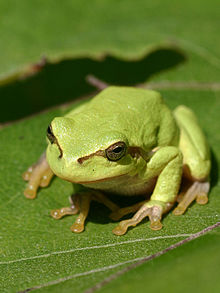| Hyla Temporal range: Eocene to recent
| |
|---|---|

| |
| European tree frog, Hyla arborea | |
| Scientific classification | |
| Domain: | Eukaryota |
| Kingdom: | Animalia |
| Phylum: | Chordata |
| Class: | Amphibia |
| Order: | Anura |
| Family: | Hylidae |
| Subfamily: | Hylinae |
| Genus: | Hyla Laurenti, 1768 |
| Species | |
|
See text | |
| Synonyms[1] | |
| |
Hyla is a genus of frogs in the tree frog family Hylidae. As traditionally defined, it was a wastebasket genus with more than 300 species found in Europe, Asia, Africa, and across the Americas. After a major revision of the family, most of these have been moved to other genera so that Hyla now only contains 17 extant (living) species from Europe, northern Africa and Asia.[2] The earliest known fossil member of this genus is †Hyla swanstoni from the Eocene of Saskatchewan, Canada,[3] but its designation to Hyla happened before the major revision, meaning that its position needs confirmation.
The genus was established by Josephus Nicolaus Laurenti in 1768. It was named after Hylas in Greek mythology, the companion of Hercules. The name is unusual in that – though Laurenti knew that Hylas was male – the name is unambiguously treated in the feminine grammatical gender for reasons unknown. The etymology of the name is also often incorrectly given as being derived from the Greek word ὕλη (hūlē, "forest" or "wood").[4][5]
- ^ "Hyla". Global Biodiversity Information Facility. Retrieved 24 June 2021.
- ^ Faivovich, J.; Haddad, C.F.B.; Garcia, P.C.A.; Frost, D.R.; Campbell, J.A.; Wheeler, W.C., 2005: Systematic Review of the Frog Family Hylidae, with Special Reference to Hylinae: Phylogenetic Analysis and Taxonomic Revision. Bulletin of the American Museum of Natural History, Num. 294, pp.1-240. (http://digitallibrary.amnh.org/dspace/bitstream/2246/462/1/B294.pdf)
- ^ "Fossilworks: Hyla". fossilworks.org. Retrieved 17 December 2021.
- ^ Charles W. Myers & Richard B. Stothers (2006). "The myth of Hylas revisited: the frog name Hyla and other commentary on Specimen medicum (1768) of J. N. Laurenti, the "father of herpetology"". Archives of Natural History. 33 (2): 241–266. doi:10.3366/anh.2006.33.2.241.
- ^ "hyla". Oxford English Dictionary (Online ed.). Oxford University Press. (Subscription or participating institution membership required.) It gives the 'wood' etymology.